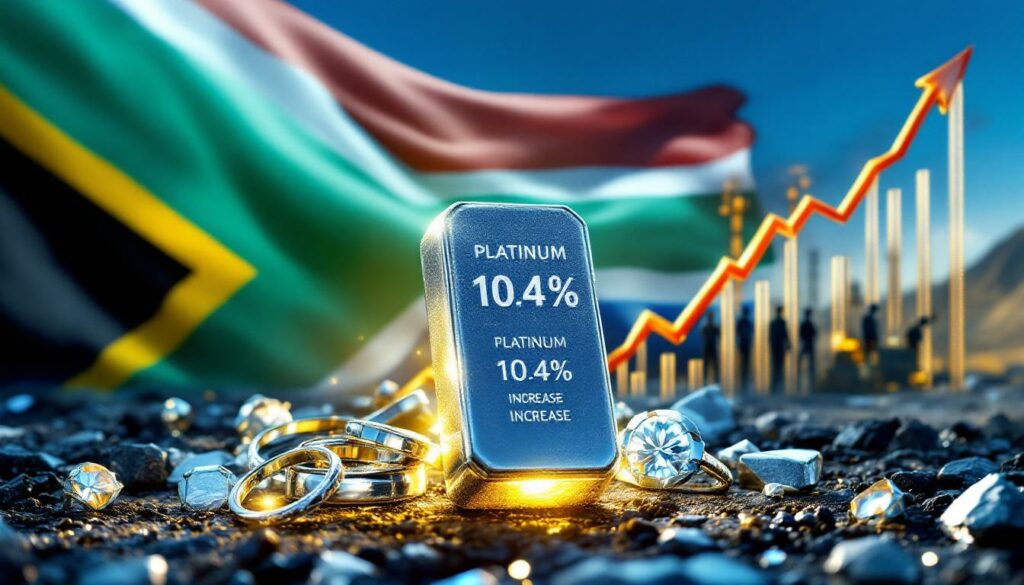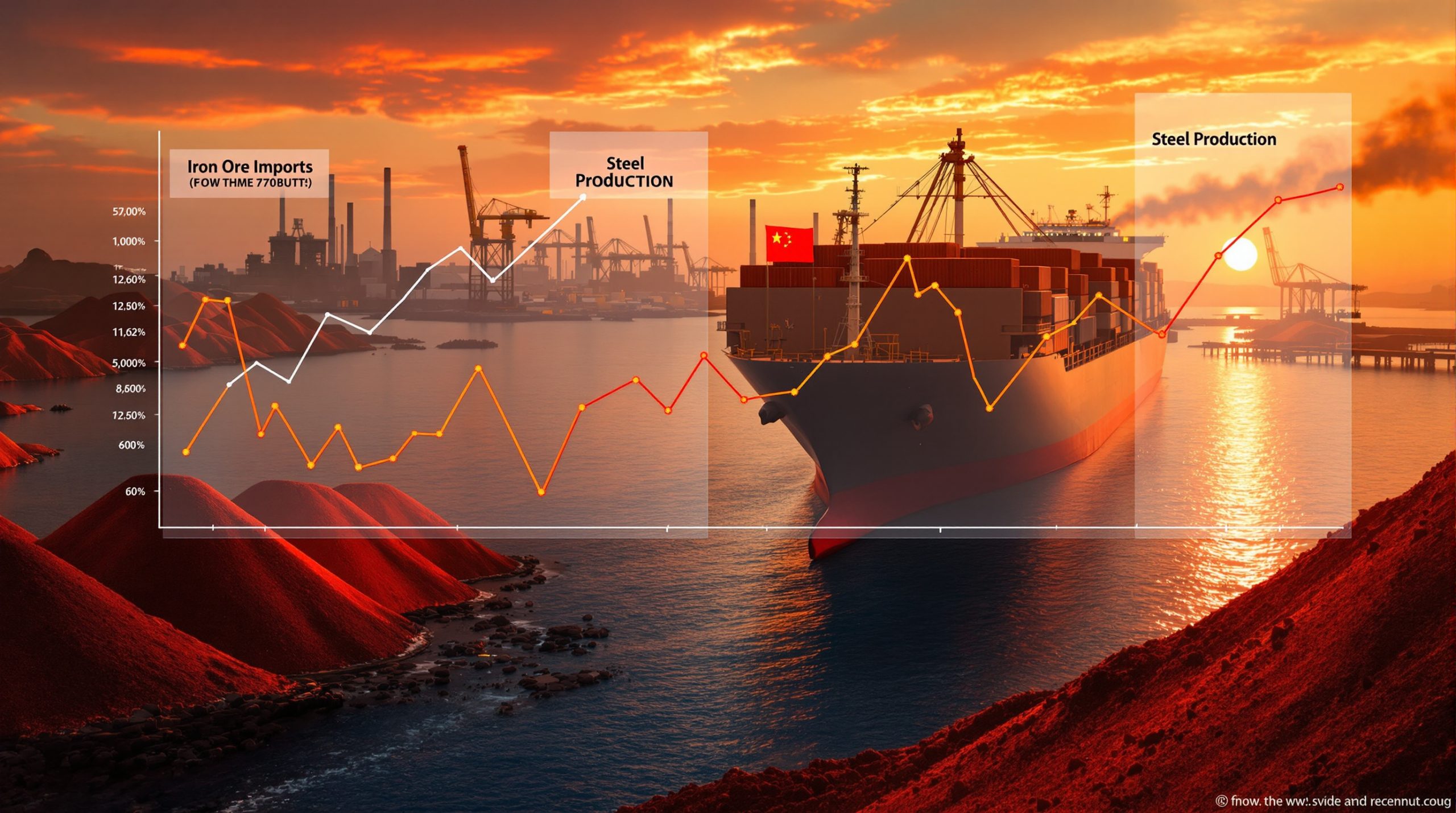South African PGM Sector: Production Recovery and Market Outlook
After facing significant challenges in early 2025, South Africa's platinum group metals (PGM) sector is showing encouraging signs of recovery. The latest data reveals a substantial turnaround in production metrics, with broader implications for global supply chains and market dynamics.
Production Recovery Indicators
Recent statistics from South Africa's platinum sector reveal a significant positive shift in production trajectories. According to Statistics South Africa's July 2025 report, PGM production increased by 10.4% month-on-month in May 2025, marking an important milestone in the industry's recovery journey.
"This improvement has reduced the year-to-date production decline from -16% in April to -12% by the end of May," notes RMB Morgan Stanley's analysis, indicating that mining companies are successfully implementing catch-up strategies after early-year disruptions.
Production measurements reflect refined mine-gate sales volumes, which analysts caution may include some pipeline metal. This technical distinction is important for investors tracking real-time production recovery.
Understanding Q1 2025 Production Challenges
The primary disruption factor behind early 2025's production challenges was unprecedented precipitation levels across South Africa's mining regions. Meteorological data confirms approximately 300mm of rainfall occurred within a 24-hour period at some operations – far exceeding historical norms.
Valterra's Amandelbult complex near Polokwane experienced particularly severe impacts. Craig Miller, Valterra's CEO, described the rainfall as "a one in 100,000 year event" (Miningmx, July 16, 2025), highlighting the exceptional nature of these weather patterns.
The financial implications have been substantial. Adrian Hammond of Standard Bank Group Securities projected that Valterra may report "33% lower sales in H1" of their financial year due to these disruptions.
The South African Geological Survey has identified the Polokwane region as having specific vulnerabilities to flash flooding due to its unique basin-like topography and clay-rich soil composition that limits water absorption during intense rainfall events.
How are global market fundamentals shaping PGM dynamics?
The broader PGM market continues to exhibit structural supply constraints against resilient demand drivers, creating a complex market environment with significant implications for price discovery and investment sentiment.
Supply-Demand Imbalance Analysis
The World Platinum Investment Council (WPIC) has revised its 2025 deficit projection upward to 966,000 ounces from an earlier estimate of 848,000 ounces, based on Metals Focus data. This substantial gap between global supply and demand underscores the market's fundamental tightness.
WPIC characterizes these deficits as "entrenched" and expects them to continue through 2029, establishing a multi-year structural imbalance in the platinum market. This deficit persistence provides important context for long-term precious metals investment strategies in the sector.
The WPIC's deficit calculations incorporate detailed modeling of automotive catalyst demand (including both conventional and hybrid vehicles), industrial applications, jewelry consumption, and investment flows. Independent analysis from S&P Global Platinum Review broadly confirms these deficit projections, though with slightly more conservative estimates.
Asian Market Developments
China, as the world's largest platinum consumer, continues to play a pivotal role in market dynamics. After a "very strong" period of platinum imports from March through mid-June 2025, recent data indicates a moderation in activity.
Shanghai Gold Exchange (SGE) volumes have "quietened down" over the past 3-4 weeks according to market observers. Current SGE inventory levels remain 22% below five-year averages despite the recent activity slowdown, indicating continued structural tightness in physical metal availability.
RMB Morgan Stanley analysts suggest this import easing could "moderate future price increases or potentially lead to corrections" in the near term, though long-term fundamentals remain supportive.
"The Chinese platinum import pattern often exhibits seasonal variation, with stronger first-half demand followed by summer moderation. However, underlying jewelry and industrial demand remains robust despite recent trading volume fluctuations." – WPIC Quarterly Market Report, July 2025
Which factors are influencing platinum demand patterns?
Multiple interconnected factors are shaping platinum consumption across various end-use sectors, with economic conditions, precious metals correlations, and industrial applications all playing significant roles.
Macroeconomic Influences
The WPIC has highlighted that "GDP growth trajectory over the next few years could significantly affect automotive and industrial demand" for platinum. This macroeconomic sensitivity reflects platinum's dual role as both an industrial metal and investment asset.
Different regional economies are showing varied consumption patterns. While European industrial demand has softened, emerging markets like India have increased platinum jewelry fabrication by approximately 18% year-over-year in 2025, diversifying demand beyond traditional Chinese consumption.
Econometric modeling suggests a strong correlation between manufacturing PMI indices and platinum industrial demand, with a 1-point PMI increase typically associated with a 0.8% rise in platinum consumption with a 3-month lag.
Precious Metals Relationships
The elevated gold price environment is driving increased substitution toward platinum in both investment and jewelry applications. With gold trading at historic highs, platinum's relative affordability has enhanced its appeal to cost-conscious consumers and diversification-focused investors.
The gold-platinum ratio remains well above historical averages, creating what analysts term a "value proposition" for platinum. This price relationship has historically been a reliable indicator of future platinum price movements.
Recent data shows platinum ETF holdings have increased by 120,000 ounces since March 2025, reversing the outflow trend of the previous 18 months. This shift coincides with the global gold price analysis showing record highs, making platinum increasingly attractive as an alternative precious metal.
Automotive Sector Dynamics
Despite concerns about electric vehicle transitions affecting platinum demand, hybrid vehicle growth continues to provide substantial support. Afriforesight forecasts that "hybrid vehicle sales will buoy platinum through 2026" as automakers optimize powertrain portfolios.
Recent US–China trade impact on the automotive sector is estimated to affect only 112,000 ounces in demand, representing just 1.4% of total platinum consumption. This limited impact has reassured market participants concerned about trade policy disruptions.
The International Energy Agency's Global EV Outlook projects hybrid vehicle production to increase at a 14% compound annual growth rate through 2027, providing sustained catalyst demand despite pure battery electric vehicle growth.
What's the outlook for South Africa's PGM mining sector?
South African producers are implementing strategic responses to both operational challenges and evolving market conditions, with implications for production volumes, corporate strategies, and investment decisions.
Operational Recovery Strategies
Mining companies are implementing accelerated production schedules to recover Q1 shortfalls. These catch-up strategies include:
- Extended shift patterns at operations with minimal weather impact
- Prioritization of higher-grade mining areas to maximize metal output
- Streamlined processing to reduce bottlenecks in the refining pipeline
- Postponement of non-essential maintenance activities where safely possible
These efforts are yielding measurable results, as evidenced by the May production rebound. Mine productivity metrics show a 6.8% improvement in output per ton processed compared to Q1 levels, indicating successful operational adjustments.
Corporate Strategic Developments
Beyond immediate recovery efforts, South African miners are making longer-term strategic adjustments. Companies like Southern Palladium are implementing staged project rollouts at developments such as the Bengwenyama project, minimizing capital risk while maintaining expansion opportunities.
Tharisa has recalibrated its production guidance following operational challenges, demonstrating the industry's commitment to transparent communication with investors during recovery periods.
Portfolio optimization remains a focus across the sector. Implats' recent closure of its Lac Des Illes mine in Canada highlights how global producers are evaluating asset performance and concentrating resources on their most productive operations.
The sector's capital expenditure trends reflect this cautious approach, with several producers adopting phased funding structures that allow flexibility as market conditions evolve. These adjustments are part of the broader mining industry evolution occurring globally.
"Our industry has demonstrated remarkable resilience in the face of extraordinary challenges. The production recovery we're seeing confirms South Africa's enduring importance to global platinum supply." – Craig Miller, Valterra CEO (June 2025)
Which indicators will determine future PGM price movements?
A complex interplay of supply, demand, and market sentiment factors will influence PGM price trajectories, with several key indicators providing insights into potential future movements.
Critical Market Signals
Analysts identify several key metrics that will drive platinum price discovery:
- Chinese consumption patterns: Jewelry and investment demand from the world's largest platinum market
- South African output recovery: Speed and completeness of production normalization
- Global economic indicators: Manufacturing PMIs and automotive production forecasts
- Cross-commodity relationships: Gold-platinum ratio and other precious metals correlations
- Automotive technology adoption: Hybrid vehicle growth rates versus EV transition pace
Price sensitivity analysis suggests that a 1% drop in South African output typically correlates with a 2.1% price increase, based on 2020-2024 market behavior. This relationship underscores the importance of production statistics as leading indicators for price movements.
Market Sentiment Barometers
Exchange trading volumes, particularly on the Shanghai Gold Exchange, provide important real-time indicators of market sentiment. The recent moderation in SGE activity after the March-June strength has coincided with platinum price stabilization.
Analyst consensus shifts from research bodies like WPIC and independent consultancies offer forward-looking insights. The recent upward revision of the 2025 deficit projection from 848,000 to 966,000 ounces signals increased market tightness expectations.
Global recycling supply dynamics also influence price discovery. Sibanye-Stillwater's $82 million recycling expansion represents a significant investment in this growing supply channel, though primary mining remains the dominant source of platinum.
The World Bank's commodity price projections indicate platinum prices could average 8-12% higher in 2026 compared to 2025 levels, assuming continued economic growth and stable automotive demand. Understanding these trends requires deeper South Africa beneficiation insights as the country moves to capture more value from its mineral resources.
FAQ: South Africa's PGM Sector Recovery
What weather conditions disrupted PGM production in early 2025?
Extreme rainfall events exceeding 300mm in 24 hours affected multiple mining operations, with Valterra's Amandelbult complex near Polokwane experiencing what CEO Craig Miller described as "a one in 100,000 year event." The South African Weather Service confirmed these precipitation levels were approximately 400% above historical averages for the region.
How significant is the current PGM market deficit?
The World Platinum Investment Council projects a 966,000-ounce deficit for 2025, representing a substantial gap between global supply and demand that is expected to persist through 2029. For context, this deficit represents approximately 12% of annual global platinum demand, significantly exceeding the 5-year average deficit of around 340,000 ounces.
What role do hybrid vehicles play in platinum demand?
Growing hybrid vehicle production is providing crucial support for platinum demand through at least 2026, helping to offset potential demand reduction from battery-electric vehicle adoption. Hybrid catalysts typically contain 50-70% more platinum than comparable conventional gasoline vehicles due to their complex emissions control requirements and frequent cold-starts.
How are Chinese platinum imports trending in 2025?
After a "very strong" period from March through mid-June, Chinese platinum imports have moderated in recent weeks, potentially signaling a shift in market dynamics. This pattern resembles the seasonal trend observed in previous years, though absolute import volumes remain approximately 15% above 2024 levels despite the recent moderation.
What's the industry outlook on platinum price sustainability?
Industry leaders, including Valterra CEO Craig Miller, have expressed confidence in the sustainability of recent price improvements, supported by persistent structural deficits projected through 2029. Technical analysis suggests the market has established a new support level approximately 22% above the 5-year average, with resistance levels approximately 15-18% above current prices.
Further Exploration:
Readers interested in learning more about South Africa's platinum mining sector can also explore related educational content from Mining Technology's analysis of platinum mining in uncertain times and The Hidden Revival of Platinum and Palladium, which regularly publishes analysis on developments in the PGM industry.
Want to Invest in the Next Major Mineral Discovery?
Discovery Alert instantly notifies investors of significant ASX mineral discoveries using its proprietary Discovery IQ model, turning complex mineral data into actionable insights. Understand why historic discoveries can generate substantial returns by visiting Discovery Alert's dedicated discoveries page and begin your 30-day free trial today to position yourself ahead of the market.




